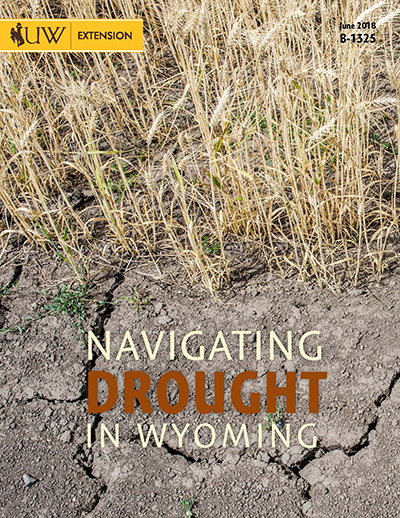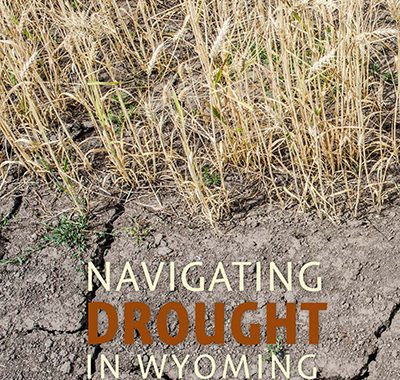As the spring grazing season approaches, it is important that we start to monitor the drought situation and be prepared.
Figure 1 shows the drought status as of March 1, 2022 across Wyoming. Throughout the state, we are currently in a Moderate to Extreme drought. Therefore, it is important that we start monitoring our local drought status and create a drought management plan.

To better prepare for a drought, we must know key precipitation events associated with the plant community in our pastures. Pastures dominated by warm-season species thrive with May-July precipitation, but pastures dominated by cool-season species thrive with earlier precipitation events (April-May) (Stephenson, 2021; Arterburn, 2017). There is a correlation between the number of precipitation events greater than 0.10 inches and forage production. Every event that contributes more than a tenth of an inch of precipitation can result in an increase of forage biomass by 80 to 90 lbs. per acre (Stephenson, 2021). Therefore, it is important to track precipitation amounts.
Understanding the trigger dates of when precipitation is needed for the forage found in our pastures can help us improve our grazing management plan by ensuring that we are meeting our livestock dry matter intake needs while not overgrazing pastures. During a drought, it is important that we are not overgrazing our pastures so that our native species can recover properly. Therefore, an important part of having a drought management plan is having key dates where we will evaluate the total precipitation received (our drought status) and creating and regularly revisiting a drought management plan that realistically fits our goals, objectives, and resources.
When creating a drought management plan, it is important that we evaluate our objectives and goals. When creating our objectives, consider what works best for our operation based on the resources available.

When making a good decision, an appropriate decision period must be established and the decision should implement your objectives (Parsons, 2021). Additionally, you must create alternatives and evaluate those alternatives using tradeoffs using sound reasoning based on your objectives and the resources you have available. Order matters: when making a proactive decision, it is important that create a clear set of objectives first, then evaluate the alternatives to reach these objectives. Finally, it is important that we commit to our decision and implement the plan.
When deciding to lease pasture ground, consider drought when creating the lease (Jansen, 2020). To implement drought in the lease, be explicit about the impacts of precipitation on forage to avoid overgrazing yet assuring that we don’t short our cattle on feed. The landlord and the lessee should agree on how much of the forage can be grazed and how cattle will be moved out. Additionally, a mutual solution to adjust the rental rate if cattle are moved out early should be established in the lease. With clear communication, considering drought in the lease can reduce stress on both the landlord and the lessee.
Federal assistance insurance is available to help mitigate the risk and loses caused by a drought. Pasture Range and Forage (PRF) is federally subsidized grazing land insurance based on rainfall (Jansen, 2020). The deadline for this is usually around November, so producers should reach a United States Department of Agriculture (USDA) agent beforehand. Farm Service Agency (FSA) provides financial assistance through livestock forage disasters program for producers who lease or own grazing land and are affected by drought over a period of time. However, there are compliances one must follow to be eligible. Therefore, it is important that before a grazing lease is finalized, is take it to an FSA agent for review and assurance that the drought plan in the lease follows their disaster program requirements (Beckman and Jansen, 2020).
There are several options to manage drought effects, but not all are realistic for all operations. Therefore, a producer must decide how to manage their herd during a drought based on their objectives and resources. During drought, producers may cull underperforming cows, older cows, or cows with issues such as temperament or broken mouths (Arterburn, 2017). Additionally, producers may opt to do earlier pregnancy checks and sell open cows to free up grass for bred cows. Another practice includes early weaning of calves and taking them to a dry lot (Rasby and McGee, 2011). This allows our cows to be maintained by grazing poor quality pastures or fed low quality feed because a dry cow will require less nutrients than a lactating cow. During a drought, it is important that we calculate the amount of feed we will need, secure additional feed sources ahead of time, and compare different solutions.
Preparing for a drought is important as it puts us one step ahead in mitigating risk by ensuring that we have enough feed and forage for our herd without overgrazing and deteriorating our pastures.
Drought Management Resources from UW Extension
Wyoming Conditions & Outlooks videos
The Wyoming Conditions & Outlooks presentation is recorded on the 3rd Thursday of each month starting in March 2021. The University of Wyoming Extension organizes this collaborative effort in partnership with the USDA, NOAA National Weather Service, NOAA’s Missouri River Basin Forecast Center, USGS, the Wyoming State Climate Office, the Water Resources Data System, and the Office of the Tribal Water Engineer of the Eastern Shoshone & Northern Arapaho Tribes.
Videos
Publications
- Navigating Drought in Wyoming
- Comparison of Alternative Cattle Management Strategies Under Long-Term Drought
- Considerations for Preparing a Drought Management Plan for Livestock Producers
- Two Common Drought Management Strategies and Some Considerations for Wyoming Cattle Producers
- Managing your ranch during drought: Implications from long and short-run analyses
- Recognizing and Responding to Drought on Rangelands
- Multiple Impacts – Multiple Strategies How WY Cattle Producers Survive Drought
- Flexible Grazing and Livestock Management Systems for Good and Bad Times
Barnyards and Backyards

Sources for Further Reading on Drought Management
Arterburn, J., 2017. Grazing Considerations in a Drought Year. University of Nebraska-Lincoln Beef. https://beef.unl.edu/grazing-considerations-drought-year
Beckman, B. and J. Jansen. 2020. Drought and Pasture Lease Considerations. University of Nebraska-Lincoln. https://beef.unl.edu/beefwatch/2020/drought-and-pasture-lease-considerations
Parsons, J. 2021. Preparing to Make Decisions During a Drought. University of Nebraska-Lincoln. BeefWatch Drought Management Webinar Series. https://farm.unl.edu/webinars/2021/drought-decisions-2021.pdf
Rasby, R. and D.A. McGee. 2011. Management of Early Weaned Calves. University of Nebraska-Lincoln. https://extensionpublications.unl.edu/assets/pdf/g2047.pdf
Stephenson, M., 2021. Pre-During-Post Drought Management of Rangelands. University of Nebraska-Lincoln. BeefWatch Drought Management Webinar Series. https://beef.unl.edu/beefwatch-webinar-series





